2025届高三英语二轮复习专项 双语新闻阅读与填空练习(三篇,含答案)
文档属性
| 名称 | 2025届高三英语二轮复习专项 双语新闻阅读与填空练习(三篇,含答案) | 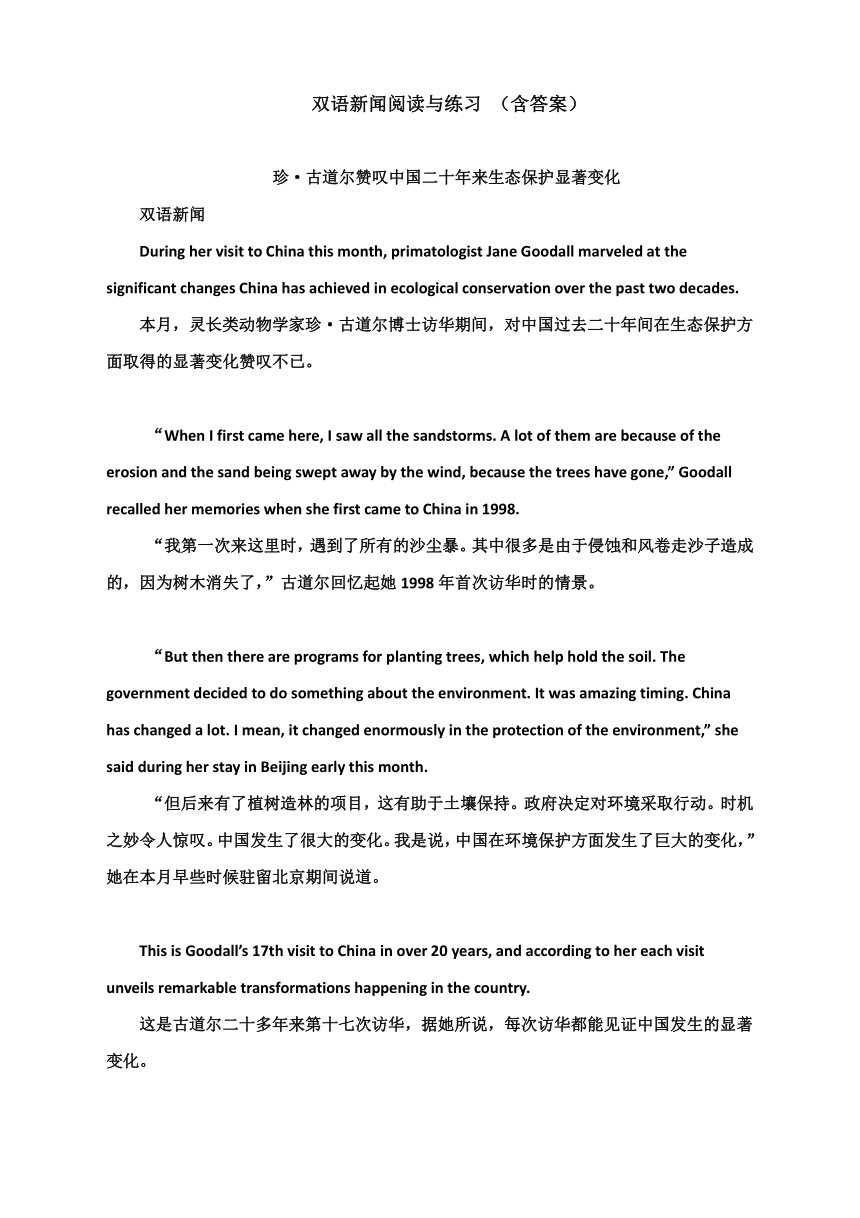 | |
| 格式 | docx | ||
| 文件大小 | 28.1KB | ||
| 资源类型 | 教案 | ||
| 版本资源 | 人教版(2019) | ||
| 科目 | 英语 | ||
| 更新时间 | 2024-12-24 17:45:33 | ||
图片预览

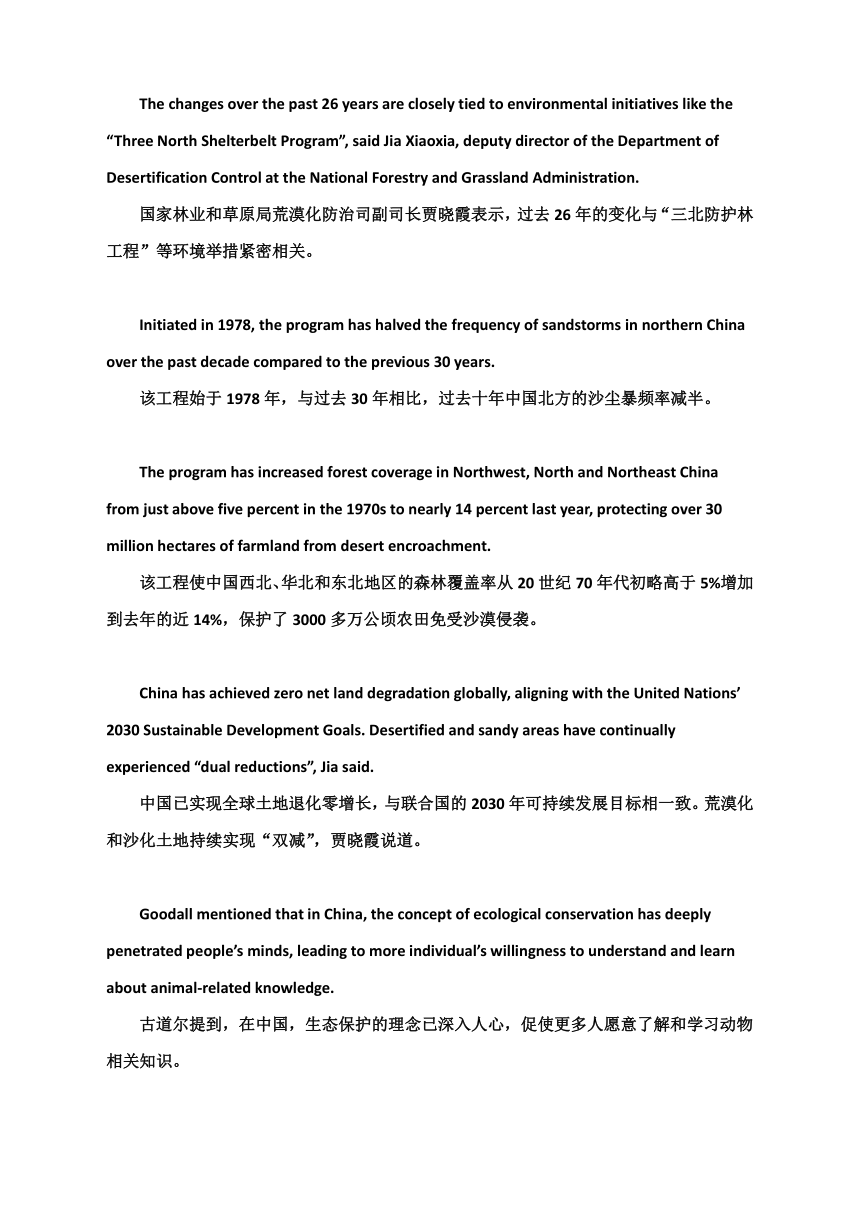
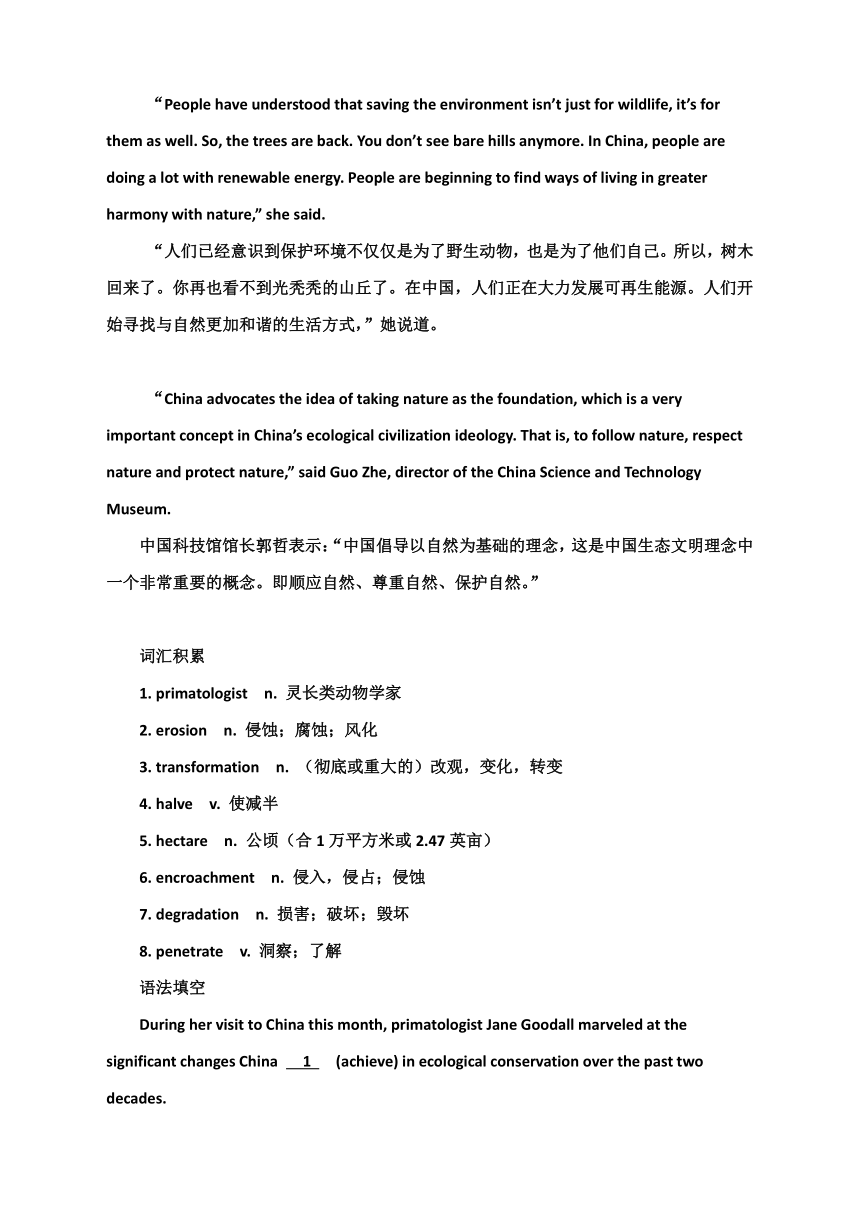
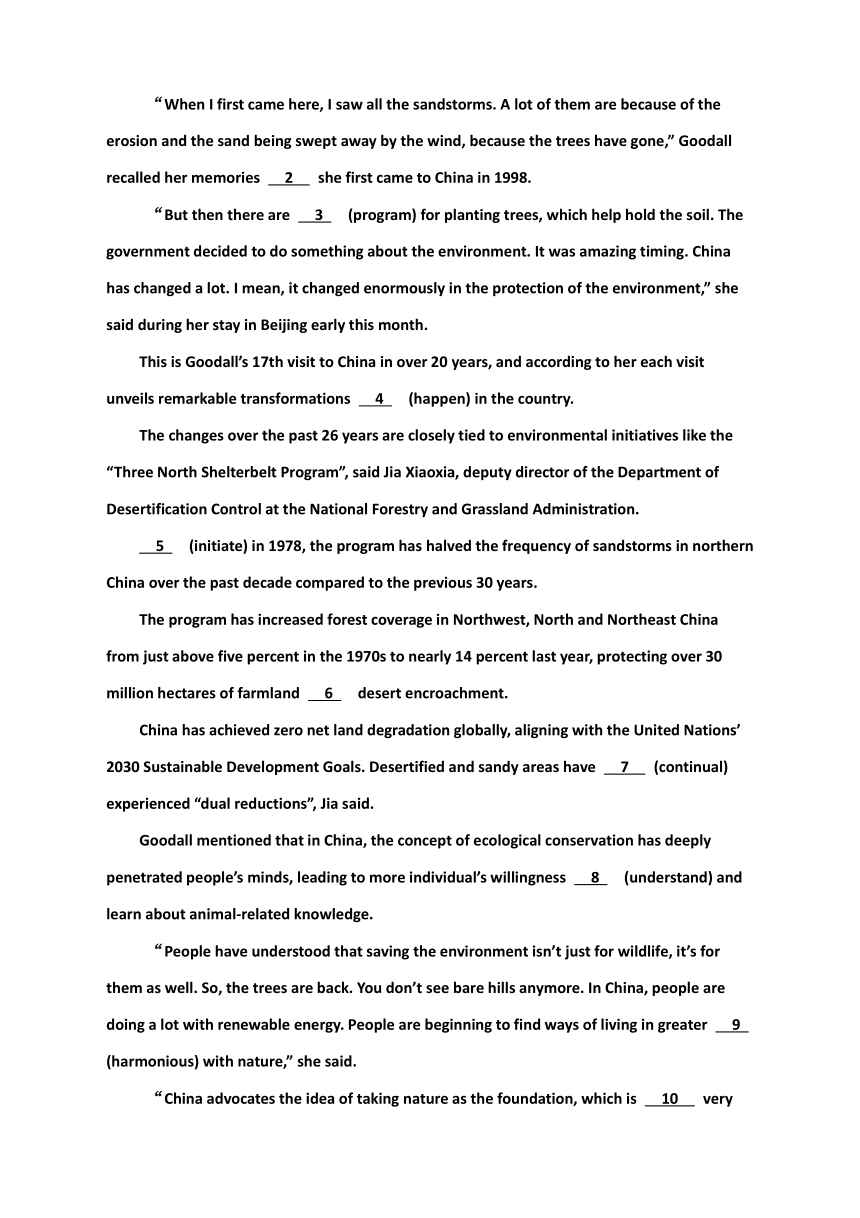
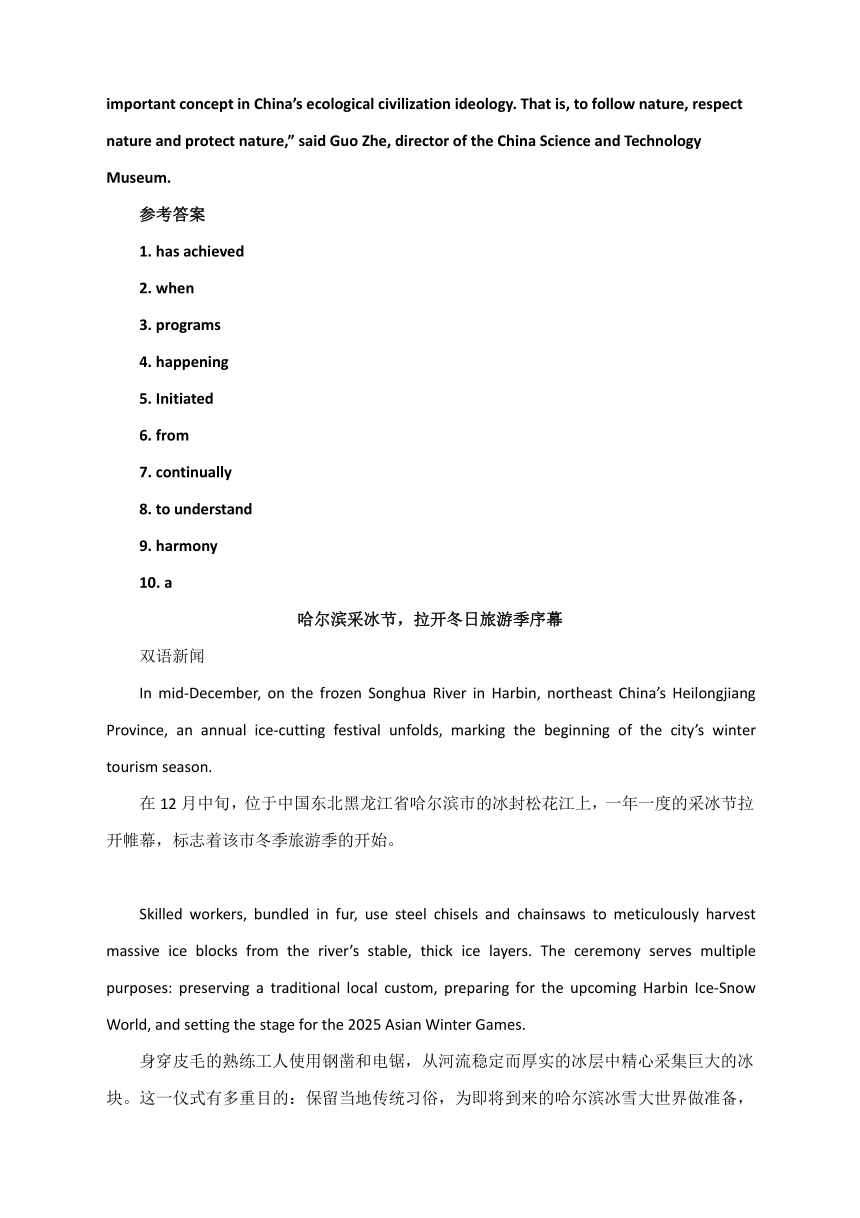
文档简介
双语新闻阅读与练习 (含答案)
珍·古道尔赞叹中国二十年来生态保护显著变化
双语新闻
During her visit to China this month, primatologist Jane Goodall marveled at the significant changes China has achieved in ecological conservation over the past two decades.
本月,灵长类动物学家珍·古道尔博士访华期间,对中国过去二十年间在生态保护方面取得的显著变化赞叹不已。
“When I first came here, I saw all the sandstorms. A lot of them are because of the erosion and the sand being swept away by the wind, because the trees have gone,” Goodall recalled her memories when she first came to China in 1998.
“我第一次来这里时,遇到了所有的沙尘暴。其中很多是由于侵蚀和风卷走沙子造成的,因为树木消失了,”古道尔回忆起她1998年首次访华时的情景。
“But then there are programs for planting trees, which help hold the soil. The government decided to do something about the environment. It was amazing timing. China has changed a lot. I mean, it changed enormously in the protection of the environment,” she said during her stay in Beijing early this month.
“但后来有了植树造林的项目,这有助于土壤保持。政府决定对环境采取行动。时机之妙令人惊叹。中国发生了很大的变化。我是说,中国在环境保护方面发生了巨大的变化,”她在本月早些时候驻留北京期间说道。
This is Goodall’s 17th visit to China in over 20 years, and according to her each visit unveils remarkable transformations happening in the country.
这是古道尔二十多年来第十七次访华,据她所说,每次访华都能见证中国发生的显著变化。
The changes over the past 26 years are closely tied to environmental initiatives like the “Three North Shelterbelt Program”, said Jia Xiaoxia, deputy director of the Department of Desertification Control at the National Forestry and Grassland Administration.
国家林业和草原局荒漠化防治司副司长贾晓霞表示,过去26年的变化与“三北防护林工程”等环境举措紧密相关。
Initiated in 1978, the program has halved the frequency of sandstorms in northern China over the past decade compared to the previous 30 years.
该工程始于1978年,与过去30年相比,过去十年中国北方的沙尘暴频率减半。
The program has increased forest coverage in Northwest, North and Northeast China from just above five percent in the 1970s to nearly 14 percent last year, protecting over 30 million hectares of farmland from desert encroachment.
该工程使中国西北、华北和东北地区的森林覆盖率从20世纪70年代初略高于5%增加到去年的近14%,保护了3000多万公顷农田免受沙漠侵袭。
China has achieved zero net land degradation globally, aligning with the United Nations’ 2030 Sustainable Development Goals. Desertified and sandy areas have continually experienced “dual reductions”, Jia said.
中国已实现全球土地退化零增长,与联合国的2030年可持续发展目标相一致。荒漠化和沙化土地持续实现“双减”,贾晓霞说道。
Goodall mentioned that in China, the concept of ecological conservation has deeply penetrated people’s minds, leading to more individual’s willingness to understand and learn about animal-related knowledge.
古道尔提到,在中国,生态保护的理念已深入人心,促使更多人愿意了解和学习动物相关知识。
“People have understood that saving the environment isn’t just for wildlife, it’s for them as well. So, the trees are back. You don’t see bare hills anymore. In China, people are doing a lot with renewable energy. People are beginning to find ways of living in greater harmony with nature,” she said.
“人们已经意识到保护环境不仅仅是为了野生动物,也是为了他们自己。所以,树木回来了。你再也看不到光秃秃的山丘了。在中国,人们正在大力发展可再生能源。人们开始寻找与自然更加和谐的生活方式,”她说道。
“China advocates the idea of taking nature as the foundation, which is a very important concept in China’s ecological civilization ideology. That is, to follow nature, respect nature and protect nature,” said Guo Zhe, director of the China Science and Technology Museum.
中国科技馆馆长郭哲表示:“中国倡导以自然为基础的理念,这是中国生态文明理念中一个非常重要的概念。即顺应自然、尊重自然、保护自然。”
词汇积累
1. primatologist n. 灵长类动物学家
2. erosion n. 侵蚀;腐蚀;风化
3. transformation n. (彻底或重大的)改观,变化,转变
4. halve v. 使减半
5. hectare n. 公顷(合1万平方米或2.47英亩)
6. encroachment n. 侵入,侵占;侵蚀
7. degradation n. 损害;破坏;毁坏
8. penetrate v. 洞察;了解
语法填空
During her visit to China this month, primatologist Jane Goodall marveled at the significant changes China 1 (achieve) in ecological conservation over the past two decades.
“When I first came here, I saw all the sandstorms. A lot of them are because of the erosion and the sand being swept away by the wind, because the trees have gone,” Goodall recalled her memories 2 she first came to China in 1998.
“But then there are 3 (program) for planting trees, which help hold the soil. The government decided to do something about the environment. It was amazing timing. China has changed a lot. I mean, it changed enormously in the protection of the environment,” she said during her stay in Beijing early this month.
This is Goodall’s 17th visit to China in over 20 years, and according to her each visit unveils remarkable transformations 4 (happen) in the country.
The changes over the past 26 years are closely tied to environmental initiatives like the “Three North Shelterbelt Program”, said Jia Xiaoxia, deputy director of the Department of Desertification Control at the National Forestry and Grassland Administration.
5 (initiate) in 1978, the program has halved the frequency of sandstorms in northern China over the past decade compared to the previous 30 years.
The program has increased forest coverage in Northwest, North and Northeast China from just above five percent in the 1970s to nearly 14 percent last year, protecting over 30 million hectares of farmland 6 desert encroachment.
China has achieved zero net land degradation globally, aligning with the United Nations’ 2030 Sustainable Development Goals. Desertified and sandy areas have 7 (continual) experienced “dual reductions”, Jia said.
Goodall mentioned that in China, the concept of ecological conservation has deeply penetrated people’s minds, leading to more individual’s willingness 8 (understand) and learn about animal-related knowledge.
“People have understood that saving the environment isn’t just for wildlife, it’s for them as well. So, the trees are back. You don’t see bare hills anymore. In China, people are doing a lot with renewable energy. People are beginning to find ways of living in greater 9 (harmonious) with nature,” she said.
“China advocates the idea of taking nature as the foundation, which is 10 very important concept in China’s ecological civilization ideology. That is, to follow nature, respect nature and protect nature,” said Guo Zhe, director of the China Science and Technology Museum.
参考答案
1. has achieved
2. when
3. programs
4. happening
5. Initiated
6. from
7. continually
8. to understand
9. harmony
10. a
哈尔滨采冰节,拉开冬日旅游季序幕
双语新闻
In mid-December, on the frozen Songhua River in Harbin, northeast China’s Heilongjiang Province, an annual ice-cutting festival unfolds, marking the beginning of the city’s winter tourism season.
在12月中旬,位于中国东北黑龙江省哈尔滨市的冰封松花江上,一年一度的采冰节拉开帷幕,标志着该市冬季旅游季的开始。
Skilled workers, bundled in fur, use steel chisels and chainsaws to meticulously harvest massive ice blocks from the river’s stable, thick ice layers. The ceremony serves multiple purposes: preserving a traditional local custom, preparing for the upcoming Harbin Ice-Snow World, and setting the stage for the 2025 Asian Winter Games.
身穿皮毛的熟练工人使用钢凿和电锯,从河流稳定而厚实的冰层中精心采集巨大的冰块。这一仪式有多重目的:保留当地传统习俗,为即将到来的哈尔滨冰雪大世界做准备,并为2025年亚洲冬季运动会奠定基础。
During peak periods, nearly a thousand ice collectors work together, extracting up to 10,000 cubic meters of ice daily. Each block is carefully cut to precise dimensions — 1.6 meters long and 0.8 meters wide — ensuring uniform density and crystal-clear texture.
在高峰期,近千名采冰工人共同工作,每天可提取多达一万立方米的冰。每块冰都被精确切割至1.6米长和0.8米宽的尺寸,以确保均匀的密度和晶莹剔透的质地。
This year’s festival attracted thousands of domestic and international tourists, fascinated by the rhythmic chants, ceremonial drums, and the spectacular ice-harvesting process. The event is part of Harbin’s broader strategy to leverage its “Ice City” reputation and boost winter tourism.
今年的节日吸引了成千上万的国内外游客,他们被节奏感十足的吟唱、仪式鼓声和壮观的采冰过程所吸引。该活动是哈尔滨更广泛战略的一部分,旨在利用其“冰城”声誉,推动冬季旅游。
In 2023, the Harbin Ice-Snow World drew over 2.7 million visitors and is expanding to cover 1 million square meters this season.
2023年,哈尔滨冰雪大世界吸引了超过270万游客,并将在本季扩展至100万平方米。
The ice-cutting tradition reflects China’s growing winter sports and tourism industry, significantly influenced by the 2022 Beijing Winter Olympics.
采冰传统反映了中国日益增长的冬季运动和旅游产业,受到2022年北京冬奥会的显著影响。
The national goal is ambitious: develop the ice-and-snow economy to reach 1.5 trillion yuan by 2030, transforming winter resources into economic opportunities.
国家目标雄心勃勃:到2030年将冰雪经济发展到1.5万亿元,将冬季资源转化为经济机遇。
For local workers like veteran ice harvester Wang Zhan, the festival represents more than an economic activity — it’s a celebration of cultural heritage, bringing traditional practices to a wider, increasingly curious audience.
对于像资深采冰工人王占这样的当地工人来说,节日不仅仅是经济活动——它是文化遗产的庆典,将传统习俗带给更广泛、越来越好奇的观众。
词汇积累
1. chisel n. 凿子
2. meticulously adv. 细致地;一丝不苟地
3. extract v. 提取;取出,拔出;设法得到
4. texture n. 质地,纹理
5. leverage v. 充分利用(资源、观点等)
语法填空
In mid-December, on the frozen Songhua River in Harbin, northeast China’s Heilongjiang Province, an annual ice-cutting festival unfolds, 1 (mark) the beginning of the city’s winter tourism season.
2 (skill) workers, bundled in fur, use steel chisels and chainsaws to meticulously harvest massive ice blocks from the river’s stable, thick ice layers. The ceremony serves multiple purposes: preserving a traditional local custom, preparing for the upcoming Harbin Ice-Snow World, and 3 (set) the stage for the 2025 Asian Winter Games.
During peak periods, nearly a thousand ice 4 (collect) work together, extracting up to 10,000 cubic meters of ice daily. Each block is 5 (careful) cut to precise dimensions — 1.6 meters long and 0.8 meters wide — ensuring uniform density and crystal-clear texture.
This year’s festival attracted thousands of domestic and international tourists, fascinated by the rhythmic chants, ceremonial drums, and the spectacular ice-harvesting process. The event is part of Harbin’s broader strategy to leverage 6 (it) “Ice City” reputation and boost winter tourism.
In 2023, the Harbin Ice-Snow World 7 (draw) over 2.7 million visitors and is expanding to cover 1 million square meters this season.
The ice-cutting tradition reflects China’s growing winter sports and tourism industry, significantly 8 (influence) by the 2022 Beijing Winter Olympics.
The national goal is ambitious: develop the ice-and-snow economy 9 (reach) 1.5 trillion Yuan by 2030, transforming winter resources into economic opportunities.
For local workers like veteran ice harvester Wang Zhan, the festival represents more than an economic activity — it’s a 10 (celebrate) of cultural heritage, bringing traditional practices to a wider, increasingly curious audience.
参考答案
1. marking
2. Skilled
3. setting
4. collectors
5. carefully
6. its
7. drew
8. influenced
9. to reach
10. celebration
漆器大师匠心独运,让古老技艺焕发新生!
双语新闻
In a gray-tiled house along Liyang Old Street in Huangshan city, East China’s Anhui province, sits an extraordinary studio. It is the workshop of Gan Erke, a master of Chinese lacquer-ware and inheritor of the Huizhou lacquer-ware decoration technique — a national-level intangible cultural heritage.
在位于中国东部安徽省黄山市黎阳老街的一座古朴灰瓦建筑内,隐匿着一个非凡的工作室。这里是中国漆器艺术大师甘而可的创作空间,同时,他也是徽州漆器髹饰技艺这一国家级非物质文化遗产的传承人。
Gan devoted his life to creating exquisite lacquer-ware pieces while reviving some elements of the craft that were close to being lost. His aim is to elevate this ancient art form to new heights while preserving its essence and maintaining China’s world-class standards.
甘而可一生致力于创作精美的漆器作品,同时复兴了一些几近失传的技艺元素。他的目标是在保持漆器精髓和中国世界级水准的同时,将这种古老的艺术形式推向新的高度。
Lacquer ware, an ancient decorative technique, involves coating objects with natural sap from lacquer trees. China is considered its birthplace, as evidenced by findings from the Jingtoushan site in East China’s Zhejiang province, revealing that ancient Chinese were among the first to utilize lacquer tree sap some 8,000 years ago.
漆器是一种古老的装饰技艺,涉及将漆树的自然树脂涂覆在物体上。中国被认为是漆器的发源地,华东浙江省的井头山遗址出土文物表明,早在约8000年前,古代中国人就开始利用漆树树脂。
The Huizhou lacquer ware technique, with its thousand-year history, is known for its refinement and elegance, contrasting with northern China’s more robust style. The local craft reached its zenith during the Ming (1368–1644) and Qing (1644–1911) dynasties.
拥有千年历史的徽州漆器技艺以其精致典雅著称,与北方更为粗犷的风格形成鲜明对比。这项当地工艺在明(1368–1644年)清(1644–1911年)两代达到了鼎盛。
Creating lacquer ware demands patience and precision. A single piece requires at least three to four months, or even a year, to complete. The process involves multiple steps — forming the base, sanding, applying coats of colored lacquer, drying, repeating lacquer coats and drying dozens of times, followed by sanding the finish, buffing and polishing — resulting in a brilliant surface with dynamic patterns in contrasting hues.
制作漆器需要耐心和精准。完成一件作品至少需要三到四个月,甚至长达一年的时间。制作过程包括多个步骤——制作基底、打磨、上色涂漆、干燥、重复涂漆和干燥数十次,最后再进行打磨、擦拭和抛光,使漆器表面光亮,呈现出对比鲜明、生动多变的图案。
词汇积累
1. lacquer-ware n. 漆器
2. inheritor n. 后继者;继承人
3. elevate v. 提升;提高
4. essence n. 本质;实质;精髓
5. coat v. 用……覆盖;在……上涂
6. sap n. (植物内输送养分的)汁,液
7. utilize v. 利用;使用;应用
8. refinement n. (精细的)改进,改善
9. zenith n. 鼎盛时期;顶点;极点
10. sand v. 用砂纸打磨
11. buff v. 擦亮
12. hue n. 颜色;色度;色调;类型;样式
语法填空
In a gray-tiled house along Liyang Old Street in Huangshan city, East China’s Anhui province, sits 1 extraordinary studio. It is the workshop of Gan Erke, a master of Chinese lacquer-ware and 2 (inherit) of the Huizhou lacquer ware decoration technique — a national-level intangible cultural heritage.
Gan devoted his life 3 creating exquisite lacquer ware pieces while reviving some elements of the craft that were close to being lost. His aim is to elevate this ancient art form to new heights while preserving its essence 4 maintaining China’s world-class standards.
lacquer ware, an ancient decorative technique, involves coating objects with natural sap from lacquer trees. China 5 (consider) its birthplace, as evidenced by findings from the Jingtoushan site in East China’s Zhejiang province, revealing that ancient Chinese were among the first 6 (utilize) lacquer tree sap some 8,000 years ago.
The Huizhou lacquer ware technique, with its thousand-year history, is known for its refinement and 7 (elegant), contrasting with northern China’s more robust style. The local craft reached 8 (it) zenith during the Ming (1368–1644) and Qing (1644–1911) dynasties.
Creating lacquer ware demands patience and precision. A single piece requires at least three to four months, or even a year, to complete. The process involves multiple 9 (step) — forming the base, sanding, applying coats of colored lacquer, drying, repeating lacquer coats and drying dozens of times, followed by sanding the finish, buffing and polishing — 10 (result) in a brilliant surface with dynamic patterns in contrasting hues.
参考答案
1. an
2. inheritor
3. to
4. and
5. is considered
6. to utilize
7. elegance
8. its
9. steps
10. resulting
珍·古道尔赞叹中国二十年来生态保护显著变化
双语新闻
During her visit to China this month, primatologist Jane Goodall marveled at the significant changes China has achieved in ecological conservation over the past two decades.
本月,灵长类动物学家珍·古道尔博士访华期间,对中国过去二十年间在生态保护方面取得的显著变化赞叹不已。
“When I first came here, I saw all the sandstorms. A lot of them are because of the erosion and the sand being swept away by the wind, because the trees have gone,” Goodall recalled her memories when she first came to China in 1998.
“我第一次来这里时,遇到了所有的沙尘暴。其中很多是由于侵蚀和风卷走沙子造成的,因为树木消失了,”古道尔回忆起她1998年首次访华时的情景。
“But then there are programs for planting trees, which help hold the soil. The government decided to do something about the environment. It was amazing timing. China has changed a lot. I mean, it changed enormously in the protection of the environment,” she said during her stay in Beijing early this month.
“但后来有了植树造林的项目,这有助于土壤保持。政府决定对环境采取行动。时机之妙令人惊叹。中国发生了很大的变化。我是说,中国在环境保护方面发生了巨大的变化,”她在本月早些时候驻留北京期间说道。
This is Goodall’s 17th visit to China in over 20 years, and according to her each visit unveils remarkable transformations happening in the country.
这是古道尔二十多年来第十七次访华,据她所说,每次访华都能见证中国发生的显著变化。
The changes over the past 26 years are closely tied to environmental initiatives like the “Three North Shelterbelt Program”, said Jia Xiaoxia, deputy director of the Department of Desertification Control at the National Forestry and Grassland Administration.
国家林业和草原局荒漠化防治司副司长贾晓霞表示,过去26年的变化与“三北防护林工程”等环境举措紧密相关。
Initiated in 1978, the program has halved the frequency of sandstorms in northern China over the past decade compared to the previous 30 years.
该工程始于1978年,与过去30年相比,过去十年中国北方的沙尘暴频率减半。
The program has increased forest coverage in Northwest, North and Northeast China from just above five percent in the 1970s to nearly 14 percent last year, protecting over 30 million hectares of farmland from desert encroachment.
该工程使中国西北、华北和东北地区的森林覆盖率从20世纪70年代初略高于5%增加到去年的近14%,保护了3000多万公顷农田免受沙漠侵袭。
China has achieved zero net land degradation globally, aligning with the United Nations’ 2030 Sustainable Development Goals. Desertified and sandy areas have continually experienced “dual reductions”, Jia said.
中国已实现全球土地退化零增长,与联合国的2030年可持续发展目标相一致。荒漠化和沙化土地持续实现“双减”,贾晓霞说道。
Goodall mentioned that in China, the concept of ecological conservation has deeply penetrated people’s minds, leading to more individual’s willingness to understand and learn about animal-related knowledge.
古道尔提到,在中国,生态保护的理念已深入人心,促使更多人愿意了解和学习动物相关知识。
“People have understood that saving the environment isn’t just for wildlife, it’s for them as well. So, the trees are back. You don’t see bare hills anymore. In China, people are doing a lot with renewable energy. People are beginning to find ways of living in greater harmony with nature,” she said.
“人们已经意识到保护环境不仅仅是为了野生动物,也是为了他们自己。所以,树木回来了。你再也看不到光秃秃的山丘了。在中国,人们正在大力发展可再生能源。人们开始寻找与自然更加和谐的生活方式,”她说道。
“China advocates the idea of taking nature as the foundation, which is a very important concept in China’s ecological civilization ideology. That is, to follow nature, respect nature and protect nature,” said Guo Zhe, director of the China Science and Technology Museum.
中国科技馆馆长郭哲表示:“中国倡导以自然为基础的理念,这是中国生态文明理念中一个非常重要的概念。即顺应自然、尊重自然、保护自然。”
词汇积累
1. primatologist n. 灵长类动物学家
2. erosion n. 侵蚀;腐蚀;风化
3. transformation n. (彻底或重大的)改观,变化,转变
4. halve v. 使减半
5. hectare n. 公顷(合1万平方米或2.47英亩)
6. encroachment n. 侵入,侵占;侵蚀
7. degradation n. 损害;破坏;毁坏
8. penetrate v. 洞察;了解
语法填空
During her visit to China this month, primatologist Jane Goodall marveled at the significant changes China 1 (achieve) in ecological conservation over the past two decades.
“When I first came here, I saw all the sandstorms. A lot of them are because of the erosion and the sand being swept away by the wind, because the trees have gone,” Goodall recalled her memories 2 she first came to China in 1998.
“But then there are 3 (program) for planting trees, which help hold the soil. The government decided to do something about the environment. It was amazing timing. China has changed a lot. I mean, it changed enormously in the protection of the environment,” she said during her stay in Beijing early this month.
This is Goodall’s 17th visit to China in over 20 years, and according to her each visit unveils remarkable transformations 4 (happen) in the country.
The changes over the past 26 years are closely tied to environmental initiatives like the “Three North Shelterbelt Program”, said Jia Xiaoxia, deputy director of the Department of Desertification Control at the National Forestry and Grassland Administration.
5 (initiate) in 1978, the program has halved the frequency of sandstorms in northern China over the past decade compared to the previous 30 years.
The program has increased forest coverage in Northwest, North and Northeast China from just above five percent in the 1970s to nearly 14 percent last year, protecting over 30 million hectares of farmland 6 desert encroachment.
China has achieved zero net land degradation globally, aligning with the United Nations’ 2030 Sustainable Development Goals. Desertified and sandy areas have 7 (continual) experienced “dual reductions”, Jia said.
Goodall mentioned that in China, the concept of ecological conservation has deeply penetrated people’s minds, leading to more individual’s willingness 8 (understand) and learn about animal-related knowledge.
“People have understood that saving the environment isn’t just for wildlife, it’s for them as well. So, the trees are back. You don’t see bare hills anymore. In China, people are doing a lot with renewable energy. People are beginning to find ways of living in greater 9 (harmonious) with nature,” she said.
“China advocates the idea of taking nature as the foundation, which is 10 very important concept in China’s ecological civilization ideology. That is, to follow nature, respect nature and protect nature,” said Guo Zhe, director of the China Science and Technology Museum.
参考答案
1. has achieved
2. when
3. programs
4. happening
5. Initiated
6. from
7. continually
8. to understand
9. harmony
10. a
哈尔滨采冰节,拉开冬日旅游季序幕
双语新闻
In mid-December, on the frozen Songhua River in Harbin, northeast China’s Heilongjiang Province, an annual ice-cutting festival unfolds, marking the beginning of the city’s winter tourism season.
在12月中旬,位于中国东北黑龙江省哈尔滨市的冰封松花江上,一年一度的采冰节拉开帷幕,标志着该市冬季旅游季的开始。
Skilled workers, bundled in fur, use steel chisels and chainsaws to meticulously harvest massive ice blocks from the river’s stable, thick ice layers. The ceremony serves multiple purposes: preserving a traditional local custom, preparing for the upcoming Harbin Ice-Snow World, and setting the stage for the 2025 Asian Winter Games.
身穿皮毛的熟练工人使用钢凿和电锯,从河流稳定而厚实的冰层中精心采集巨大的冰块。这一仪式有多重目的:保留当地传统习俗,为即将到来的哈尔滨冰雪大世界做准备,并为2025年亚洲冬季运动会奠定基础。
During peak periods, nearly a thousand ice collectors work together, extracting up to 10,000 cubic meters of ice daily. Each block is carefully cut to precise dimensions — 1.6 meters long and 0.8 meters wide — ensuring uniform density and crystal-clear texture.
在高峰期,近千名采冰工人共同工作,每天可提取多达一万立方米的冰。每块冰都被精确切割至1.6米长和0.8米宽的尺寸,以确保均匀的密度和晶莹剔透的质地。
This year’s festival attracted thousands of domestic and international tourists, fascinated by the rhythmic chants, ceremonial drums, and the spectacular ice-harvesting process. The event is part of Harbin’s broader strategy to leverage its “Ice City” reputation and boost winter tourism.
今年的节日吸引了成千上万的国内外游客,他们被节奏感十足的吟唱、仪式鼓声和壮观的采冰过程所吸引。该活动是哈尔滨更广泛战略的一部分,旨在利用其“冰城”声誉,推动冬季旅游。
In 2023, the Harbin Ice-Snow World drew over 2.7 million visitors and is expanding to cover 1 million square meters this season.
2023年,哈尔滨冰雪大世界吸引了超过270万游客,并将在本季扩展至100万平方米。
The ice-cutting tradition reflects China’s growing winter sports and tourism industry, significantly influenced by the 2022 Beijing Winter Olympics.
采冰传统反映了中国日益增长的冬季运动和旅游产业,受到2022年北京冬奥会的显著影响。
The national goal is ambitious: develop the ice-and-snow economy to reach 1.5 trillion yuan by 2030, transforming winter resources into economic opportunities.
国家目标雄心勃勃:到2030年将冰雪经济发展到1.5万亿元,将冬季资源转化为经济机遇。
For local workers like veteran ice harvester Wang Zhan, the festival represents more than an economic activity — it’s a celebration of cultural heritage, bringing traditional practices to a wider, increasingly curious audience.
对于像资深采冰工人王占这样的当地工人来说,节日不仅仅是经济活动——它是文化遗产的庆典,将传统习俗带给更广泛、越来越好奇的观众。
词汇积累
1. chisel n. 凿子
2. meticulously adv. 细致地;一丝不苟地
3. extract v. 提取;取出,拔出;设法得到
4. texture n. 质地,纹理
5. leverage v. 充分利用(资源、观点等)
语法填空
In mid-December, on the frozen Songhua River in Harbin, northeast China’s Heilongjiang Province, an annual ice-cutting festival unfolds, 1 (mark) the beginning of the city’s winter tourism season.
2 (skill) workers, bundled in fur, use steel chisels and chainsaws to meticulously harvest massive ice blocks from the river’s stable, thick ice layers. The ceremony serves multiple purposes: preserving a traditional local custom, preparing for the upcoming Harbin Ice-Snow World, and 3 (set) the stage for the 2025 Asian Winter Games.
During peak periods, nearly a thousand ice 4 (collect) work together, extracting up to 10,000 cubic meters of ice daily. Each block is 5 (careful) cut to precise dimensions — 1.6 meters long and 0.8 meters wide — ensuring uniform density and crystal-clear texture.
This year’s festival attracted thousands of domestic and international tourists, fascinated by the rhythmic chants, ceremonial drums, and the spectacular ice-harvesting process. The event is part of Harbin’s broader strategy to leverage 6 (it) “Ice City” reputation and boost winter tourism.
In 2023, the Harbin Ice-Snow World 7 (draw) over 2.7 million visitors and is expanding to cover 1 million square meters this season.
The ice-cutting tradition reflects China’s growing winter sports and tourism industry, significantly 8 (influence) by the 2022 Beijing Winter Olympics.
The national goal is ambitious: develop the ice-and-snow economy 9 (reach) 1.5 trillion Yuan by 2030, transforming winter resources into economic opportunities.
For local workers like veteran ice harvester Wang Zhan, the festival represents more than an economic activity — it’s a 10 (celebrate) of cultural heritage, bringing traditional practices to a wider, increasingly curious audience.
参考答案
1. marking
2. Skilled
3. setting
4. collectors
5. carefully
6. its
7. drew
8. influenced
9. to reach
10. celebration
漆器大师匠心独运,让古老技艺焕发新生!
双语新闻
In a gray-tiled house along Liyang Old Street in Huangshan city, East China’s Anhui province, sits an extraordinary studio. It is the workshop of Gan Erke, a master of Chinese lacquer-ware and inheritor of the Huizhou lacquer-ware decoration technique — a national-level intangible cultural heritage.
在位于中国东部安徽省黄山市黎阳老街的一座古朴灰瓦建筑内,隐匿着一个非凡的工作室。这里是中国漆器艺术大师甘而可的创作空间,同时,他也是徽州漆器髹饰技艺这一国家级非物质文化遗产的传承人。
Gan devoted his life to creating exquisite lacquer-ware pieces while reviving some elements of the craft that were close to being lost. His aim is to elevate this ancient art form to new heights while preserving its essence and maintaining China’s world-class standards.
甘而可一生致力于创作精美的漆器作品,同时复兴了一些几近失传的技艺元素。他的目标是在保持漆器精髓和中国世界级水准的同时,将这种古老的艺术形式推向新的高度。
Lacquer ware, an ancient decorative technique, involves coating objects with natural sap from lacquer trees. China is considered its birthplace, as evidenced by findings from the Jingtoushan site in East China’s Zhejiang province, revealing that ancient Chinese were among the first to utilize lacquer tree sap some 8,000 years ago.
漆器是一种古老的装饰技艺,涉及将漆树的自然树脂涂覆在物体上。中国被认为是漆器的发源地,华东浙江省的井头山遗址出土文物表明,早在约8000年前,古代中国人就开始利用漆树树脂。
The Huizhou lacquer ware technique, with its thousand-year history, is known for its refinement and elegance, contrasting with northern China’s more robust style. The local craft reached its zenith during the Ming (1368–1644) and Qing (1644–1911) dynasties.
拥有千年历史的徽州漆器技艺以其精致典雅著称,与北方更为粗犷的风格形成鲜明对比。这项当地工艺在明(1368–1644年)清(1644–1911年)两代达到了鼎盛。
Creating lacquer ware demands patience and precision. A single piece requires at least three to four months, or even a year, to complete. The process involves multiple steps — forming the base, sanding, applying coats of colored lacquer, drying, repeating lacquer coats and drying dozens of times, followed by sanding the finish, buffing and polishing — resulting in a brilliant surface with dynamic patterns in contrasting hues.
制作漆器需要耐心和精准。完成一件作品至少需要三到四个月,甚至长达一年的时间。制作过程包括多个步骤——制作基底、打磨、上色涂漆、干燥、重复涂漆和干燥数十次,最后再进行打磨、擦拭和抛光,使漆器表面光亮,呈现出对比鲜明、生动多变的图案。
词汇积累
1. lacquer-ware n. 漆器
2. inheritor n. 后继者;继承人
3. elevate v. 提升;提高
4. essence n. 本质;实质;精髓
5. coat v. 用……覆盖;在……上涂
6. sap n. (植物内输送养分的)汁,液
7. utilize v. 利用;使用;应用
8. refinement n. (精细的)改进,改善
9. zenith n. 鼎盛时期;顶点;极点
10. sand v. 用砂纸打磨
11. buff v. 擦亮
12. hue n. 颜色;色度;色调;类型;样式
语法填空
In a gray-tiled house along Liyang Old Street in Huangshan city, East China’s Anhui province, sits 1 extraordinary studio. It is the workshop of Gan Erke, a master of Chinese lacquer-ware and 2 (inherit) of the Huizhou lacquer ware decoration technique — a national-level intangible cultural heritage.
Gan devoted his life 3 creating exquisite lacquer ware pieces while reviving some elements of the craft that were close to being lost. His aim is to elevate this ancient art form to new heights while preserving its essence 4 maintaining China’s world-class standards.
lacquer ware, an ancient decorative technique, involves coating objects with natural sap from lacquer trees. China 5 (consider) its birthplace, as evidenced by findings from the Jingtoushan site in East China’s Zhejiang province, revealing that ancient Chinese were among the first 6 (utilize) lacquer tree sap some 8,000 years ago.
The Huizhou lacquer ware technique, with its thousand-year history, is known for its refinement and 7 (elegant), contrasting with northern China’s more robust style. The local craft reached 8 (it) zenith during the Ming (1368–1644) and Qing (1644–1911) dynasties.
Creating lacquer ware demands patience and precision. A single piece requires at least three to four months, or even a year, to complete. The process involves multiple 9 (step) — forming the base, sanding, applying coats of colored lacquer, drying, repeating lacquer coats and drying dozens of times, followed by sanding the finish, buffing and polishing — 10 (result) in a brilliant surface with dynamic patterns in contrasting hues.
参考答案
1. an
2. inheritor
3. to
4. and
5. is considered
6. to utilize
7. elegance
8. its
9. steps
10. resulting
